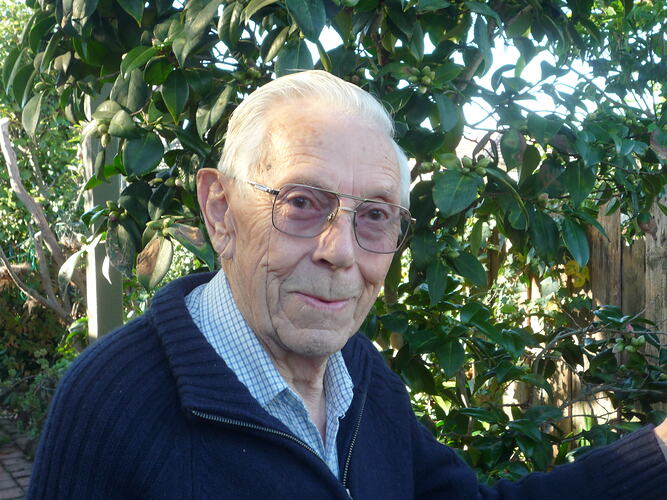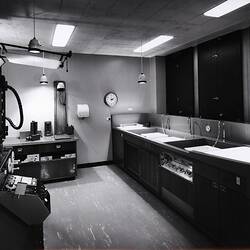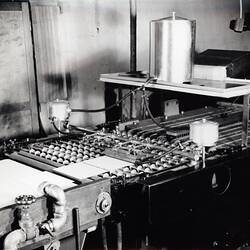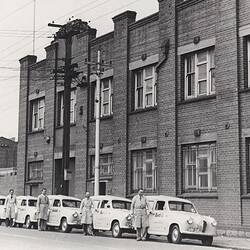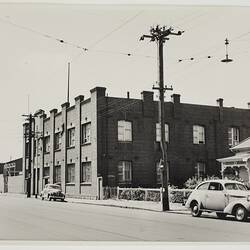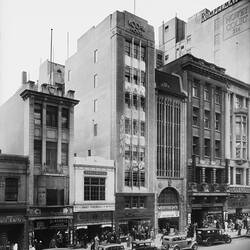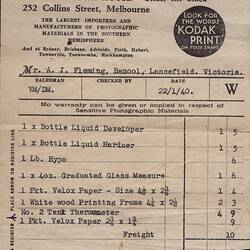Summary
From delivery boy to Assistant to the Technical Director, 1937 -1952.
John Garrett, Kodak Australasia Pty Ltd: From Delivery Boy to Assistant to the Technical Director, 1937 -1952
Delivery boy
John Garrett was a teenager when he migrated from England to Australia in 1932. After working on his brothers' farm in South Australia for three years, John moved to Melbourne looking for work. He had an interest in photography, having worked in a photographer's laboratory during school holidays in England. John happened to meet a friend of Kodak Australasia's Company Secretary J. E. Page, who organised a job interview for him. There were few vacancies at Kodak, however John was taken on as delivery boy at the Abbotsford factory in 1937.
John remembers that his 'delivery truck' was a 'six foot long wooden box on casters', which he pushed around, transporting materials and equipment between the various departments. One regular job was to take the large heavy guillotine knives used for cutting film and photographic paper to the engineering department for sharpening.
Plate department
Having done what John called 'my apprenticeship, pushing the box around', he moved into the plate department, where sheets of glass were coated with light sensitive emulsion to make photographic plates. John's job was to lift the heavy racks of glass plates from the coating machine and put them onto shelves in the drying room. This, like the coating process, was carried out in the dark, although some low intensity coloured lighting was placed at strategic points to assist employees find their way around. John recalls the difficulty of working the darkened environment:
"It used to be pretty dangerous, because glass is pretty sharp stuff. But everyone was terribly careful of course. I had one disaster in there. I got the first plate in the rack caught as I was sliding it into the thing, it went arse over turkey, knocked the other two over and they all smashed and went on the floor. So there was a hell of a lot of broken glass. ... I saw very, very little damage considering the sort of substance we were working with."
John served in the RAAF during World War II, returning to his job after the war ended in 1945.
Burnley
During the early 1950s Kodak expanded its plant to cope with the increased business of the post-war years. The company purchased the former Barnes Honey factory in Burnley, which became a new developing and printing laboratory for films sent for processing, mostly from pharmacies. Kodak had a fleet of cars to pick up and deliver every day. John transferred to the darkroom at Burnley, where his job was to open the exposed rolls of film and put them into the tanks of developing solution, dealing with 30 batches at a time. Responding to fierce competition, Kodak commenced a same day service for selected pharmacies. However, John felt that the quality of the processing sometimes suffered in the rush.
Assistant to the Technical Director
John's next move, around 1949, was to Kodak House in Collins Street Melbourne where he became assistant to the Technical Director, Eric Merton. This was the job for John, who loved photography. His office was above the shop at Kodak House, Kodak's main Melbourne retail outlet, and it included a darkroom where John could develop his own films.
The job presented John with new opportunities to benefit both Kodak and photography generally. He experimented with other brands of film, to make himself aware of the products of Kodak's competitors, and established a filing system for his findings. He assisted the public and professional photographers with their technical queries, even those related to other brands of film. John was the go-to person when customers had problems with their cameras:
"When the people used to get films in their cameras jammed they'd go to the shop downstairs, they'd say, 'Can I go to see someone about getting the film taken out.' Up would come the order, 'Hey John, would you like to unload this camera?' So into the darkroom, unload the camera, get that all working again, sort it all out, take out the bits and pieces where they've torn the film, empty the camera out, put it together. I suppose the customer would be back in an hour and pick his camera up. And he probably wouldn't be charged for that, it'd be a free service."
John occasionally visited camera clubs to advise them on developing and printing techniques and the best use of Kodak products.
Yarra Grange Loan Society
Following World War II, when housing and finance were in short supply, Kodak sponsored eight Yarra Grange Housing co-operatives, which provided housing loans for employees. John and his wife Doris checked bank interest rates and found the interest rate offered by Yarra Grange 'the ideal one to pay'. John found it easy to apply and qualify for a Yarra Grange loan to build a two-bedroom house in North Balwyn, with monthly repayments over 25 years.
Moving on from Kodak
Although John enjoyed his job and found Kodak a great place to work, he could not see any opportunities to advance his career or increase his salary. He had been promised a trip to Eastman Kodak in Rochester USA, where he could study the latest trends, but it never eventuated. Besides, Kodak's proposed move to Coburg (which took place in the 1960s) would mean further to travel to work. So, after fifteen years at Kodak, John decided to look for another job. He became a sales 'rep' in the pharmaceutical industry. Ironically, later in his career John sold x-ray film for one of Kodak's competitors.
References
Beale, Nigel, 'The History of Kodak in Australia', 1983.
HT 37042 - Oral History with John Garrett, interviewed by Lesley Alves, 1 May 2014
More Information
-
Keywords
Photography, Managers, Manufacturing, Factories, Biographies, Retailing
-
Authors
-
Article types
